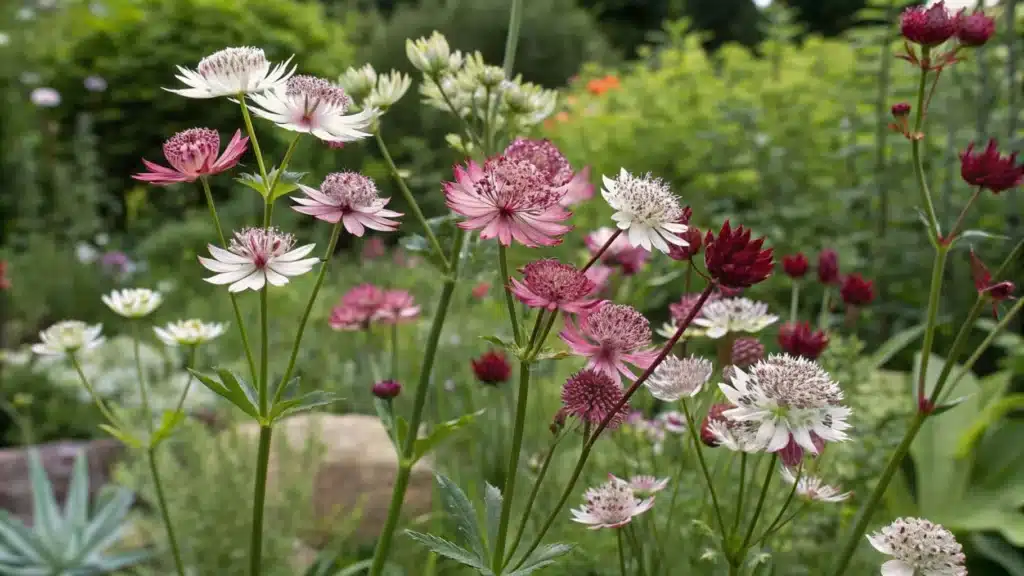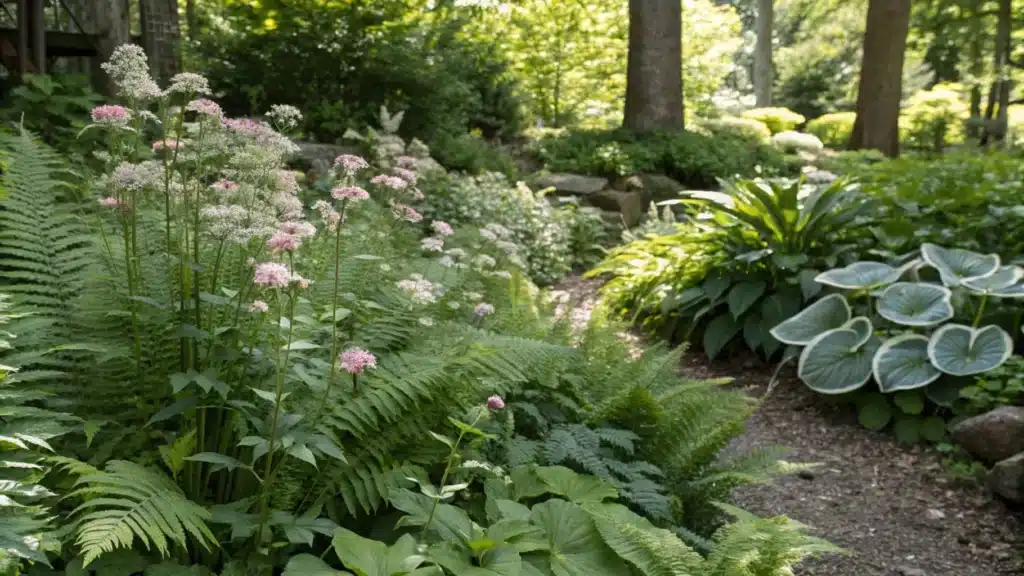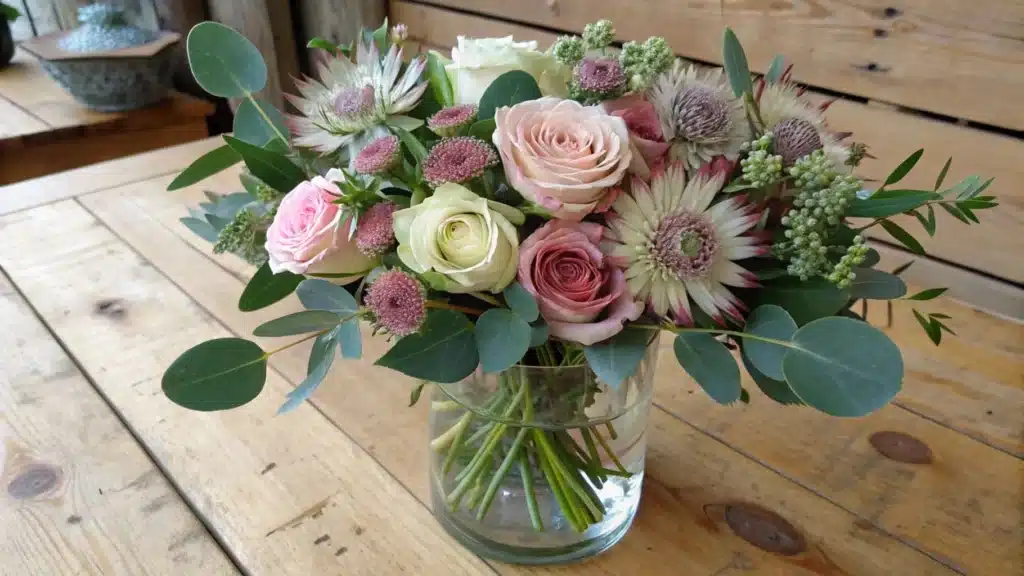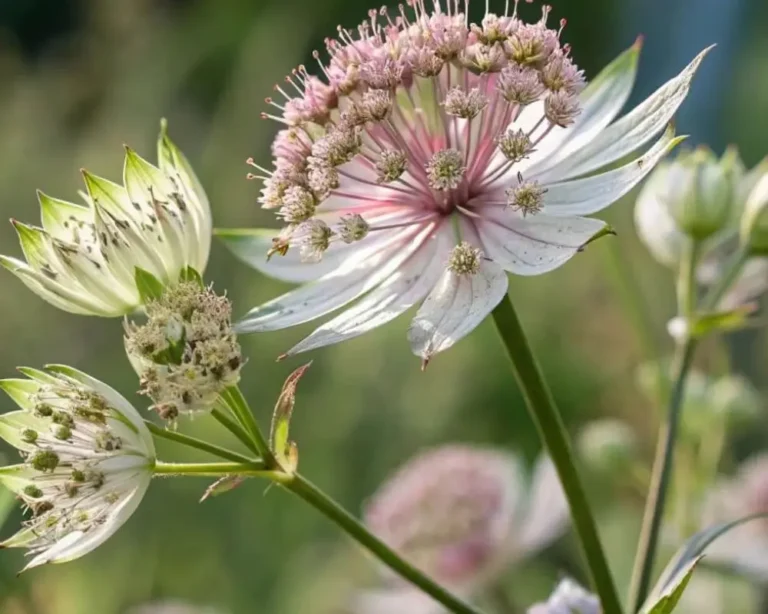Astrantia, commonly known as Masterwort, is a charming perennial that’s sure to add a touch of elegance to any garden. With their unique star-shaped blooms, these flowers are not only beautiful but also relatively easy to care for. Whether you’re a seasoned gardener or a newbie, growing Masterwort can be a rewarding experience. From choosing the right spot to understanding their watering needs, there’s a bit to learn, but once you get the hang of it, these flowers will thrive and become a staple in your garden.
Table of Contents
Understanding Astrantia: Characteristics and Varieties
Exploring Different Astrantia Species
Astrantia, often known as Masterwort, is a captivating plant with a rich history in ornamental gardening. These herbaceous perennials are native to Europe and Western Asia, and they thrive in a variety of garden settings. The plant is easily recognized by its star-shaped flowers surrounded by involucral bracts, which give it a unique, multi-dimensional appearance. There are several species, but the most common in gardens is Masterwort major, known for its adaptability and charm.
Unique Features of Masterwort Flowers
Masterwort flowers are not just visually appealing; they also play a crucial role in the ecosystem. The flowers are arranged in compact umbels, often in shades of pink, red, or white, and are a magnet for pollinators like bees and butterflies. The lobed leaf structure of Masterwort adds to its ornamental appeal and provides an interesting texture in garden designs. These plants are also remarkably resilient, often being slug and snail-proof, making them a reliable choice for gardeners.
Popular Varieties for Your Garden

When it comes to choosing the right Masterwort for your garden, the options are plentiful. Here are some popular varieties to consider:
- Astrantia major ‘Roma’: Features soft pink flowers and is a favorite for its delicate hue.
- Astrantia major ‘Venice’: Known for its deep ruby red flowers, this variety adds a dramatic touch.
- Astrantia ‘Buckland’: Ideal for pastel garden schemes with its soft green and pink bracts.
- Astrantia major ‘Hadspen Blood’: Offers very dark, deep red bracts and pink flowers, perfect for adding depth.
- Astrantia major ‘Alba’: Displays white flowers with greenish bracts, providing a classic look.
Astrantia’s adaptability and variety make it a standout in any garden. Whether you’re aiming for a cottage garden feel or a more structured design, these plants can seamlessly fit into your plans. Consider pairing them with other moisture-loving plants like Geums or Salvias for a harmonious garden palette.
Choosing the Right Location and Soil
Ideal Soil Conditions
Astrantia thrives in moist soil rich in organic matter. Loamy soil is ideal, but clay soils can work if they stay moist and don’t dry out in the heat. Sandy soils might struggle, as they often can’t keep the soil moist enough for these plants. It’s essential to ensure the soil retains moisture but drains well to avoid waterlogging.
Discover how Hostas thrive in similar shady and moist conditions as Astrantia
Finding the Perfect Spot in Your Garden
When picking a spot for astrantia, aim for a location that mimics its natural mountain meadow habitat. They do well in dappled shade, such as under trees or shrubs. However, some darker varieties prefer sunnier spots. Remember, Masterwort can also be a great underplant for taller plants like roses, filling in gaps and adding layers to your garden.
Companion Planting

Masterwort pairs beautifully with plants that enjoy similar conditions. Consider planting them alongside:
- Dryopteris (ferns)
- Geums
- Salvias
- Thalictrums
- Sambucus nigra (elderberry)
These companions help maintain a moist environment, and their diverse textures and colors can create a visually appealing landscape. Planting Masterwort with these can also help cover bare spots and provide continuous blooms throughout the season.
For a lush and thriving garden, consider the needs of each plant. Astrantia’s preference for moist soil and partial shade makes it a versatile choice for many garden styles.
Learn how to pair lavender trees with other moisture-loving plants for a harmonious garden design
Watering and Fertilizing
How to Water Astrantia Effectively
Astrantia, or masterwort, thrives in conditions that maintain consistent moisture. While it’s not a fan of soggy soil, it doesn’t handle drought well either. Watering deeply once a week is usually enough, but during particularly hot spells, you might need to increase this frequency. If you’re growing Masterwort in pots, remember they dry out faster than garden beds. Always water at the base to keep the foliage dry, reducing the risk of fungal diseases.
Astrantia plants are quite forgiving if they wilt due to lack of water. A good soak usually revives them without any long-term issues.
Nutrient Needs and Fertilization Tips
Astrantia doesn’t demand much in terms of nutrients. A single application of compost or a balanced fertilizer in early spring is typically sufficient. This provides the essential nutrients needed for the growing season. If compost isn’t available, a slow-release organic fertilizer can be a good alternative. Avoid over-fertilizing, as too much can lead to lush foliage at the expense of blooms.
Avoiding Common Watering Mistakes
- Overwatering: Masterwort likes moist soil but not waterlogged conditions. Ensure the soil drains well.
- Watering from Above: Wet foliage can attract diseases. Always water at the soil level.
- Ignoring Soil Needs: Dappled shade is ideal, but ensure the soil retains moisture without becoming too heavy.
Remember, Masterwort pairs beautifully with plants like Hostas, which also enjoy similar moist, shady conditions. This makes them excellent companions in a garden setting. By paying attention to these watering and fertilizing tips, your astrantia will flourish, adding charm and elegance to your garden.
Pruning and Maintaining
When and How to Prune Astrantia
Pruning your Astrantia is a straightforward task. Although not absolutely necessary, deadheading the flowers after their first bloom can encourage them to flower again in late summer. This simple step also helps keep the plant tidy and prevents it from self-seeding excessively. Use sharp shears to cut back the spent flower heads and any untidy green foliage.
Encouraging Reblooming
To get the most out of your Astrantia’s blooming potential, consider these tips:
- Deadhead regularly: Remove spent blooms to stimulate new growth.
- Maintain partial shade: These plants thrive best when shielded from the harsh midday sun.
- Fertilize lightly: Use a balanced fertilizer to support the plant’s nutrient needs.
Managing Self-Seeding in Your Garden
Masterwort are known for their ability to self-seed, which can be both a blessing and a curse. If you prefer a more controlled garden, it’s important to manage this aspect:
- Regularly remove spent blooms to prevent unwanted seeding.
- Consider planting in containers if you wish to contain their spread.
- Monitor the growth of seedlings and thin them out as necessary to maintain your garden’s design.
Keeping your Astrantia well-pruned not only enhances its beauty but also extends its lifespan, allowing you to enjoy those unique palmate leaf structures for many seasons.
Propagating Masterwort: Methods and Tips
Seed Propagation Techniques
Growing Astrantia from seeds is a rewarding experience, though it requires patience. Start by collecting seeds from mature plants in autumn. Ensure the day is dry to prevent mold. Sow the seeds in late summer or under cover in spring. Keep the soil moist but not waterlogged. Be aware that seedlings might not always replicate the parent plant’s color or size, but this can lead to delightful surprises in your garden.
For a detailed guide on seed propagation techniques, including germination tips and overcoming seed dormancy, check out this resource from Virginia Tech.
Dividing Astrantia for New Growth
Dividing Astrantia is a great way to produce larger flower clusters and rejuvenate older plants. The best time to do this is in spring. Carefully lift the plant with a garden fork, ensuring you don’t damage the roots. Split the root ball into sections using a spade or sharp knife. Replant these divisions immediately, maintaining adequate spacing for growth.
Ensuring Healthy Seedlings
To nurture healthy seedlings, provide them with consistent moisture and a bit of shade. Overexposure to sunlight can hinder growth. As they develop, gradually acclimate them to more sunlight. A little secret in gardening is that proper drainage is vital to prevent root rot, so ensure your soil is well-draining. Regularly check for pests that might attack young plants and treat them promptly.
Propagating Astrantia isn’t just about increasing your plant collection; it’s about sharing the joy of these unique flowers with others. Whether you’re dividing for a friend or growing from seed, each new plant is a testament to your gardening secrets.
Dealing with Pests and Diseases
Identifying Common Pests
Astrantia, often resilient in the garden, can still face challenges from pests. A common issue is the Astrantia leaf miner. This pest is the larva of a fly that feeds within the foliage, creating unsightly brown patches. While these patches might look bad, they don’t harm the flowers themselves. To manage this, simply remove the affected leaves as soon as you notice them.
Preventing and Treating Diseases
Astrantia is generally tough, but it is not completely immune to diseases. Powdery mildew is a frequent fungal problem, appearing as a white coating on leaves. To combat this, ensure good airflow around your plants by not overcrowding them. Also, water the base of the plant rather than the leaves to keep the foliage dry. In autumn, cut back the plants and dispose of any infected leaves to prevent spores from spreading in the spring.
For organic gardeners, a homemade fungicide can help. Mix 5% apple cider vinegar with a gallon of water and spray it on the leaves during cool mornings. This can help keep the mildew at bay.
Maintaining a Healthy Garden Environment
A healthy garden environment is key to preventing pests and diseases. Here are some tips:
- Mulch Regularly: Use organic matter like compost or well-rotted manure in autumn to keep the soil healthy.
- Avoid Stress: Make sure your Astrantias are well-watered, especially during dry spells, to prevent stress that can make them more susceptible to problems.
- Ensure Good Air Circulation: Space your plants appropriately and consider dividing them in spring to improve airflow.
Keeping your Astrantia plants healthy and vibrant involves a mix of good gardening practices and timely interventions. By focusing on prevention and early detection, you can enjoy the beauty of these unique flowers without worry.
Using Astrantia in Garden Design and Floral Arrangements

Incorporating Astrantia into Garden Layouts
Masterwort, with its charming pink center and diverse color palette, is a favorite among garden enthusiasts and floral designers. These flowers in summer can transform any space into a vibrant, lively area. Consider combining Masterwort with ornamental grass for a contrasting texture that adds depth to your garden. In a cottage garden setting, they pair beautifully with roses, filling in gaps between the main flush of bloom, and providing a continuous display of color.
Creating Stunning Bouquets with Astrantia
Astrantia’s unique appearance makes it a standout choice for bouquets. Their intricate blooms, often featuring a white flower with a pink center, offer a delicate touch to any arrangement. When crafting a bouquet, mix Masterwort with other seasonal flowers to create a lush, textured look. These flowers are not only beautiful fresh but also dry well, allowing you to enjoy their beauty long after the season ends.
Astrantia as Ground Cover and Focal Points
Beyond their use in bouquets, Astrantia serves as excellent ground cover, helping maintain soil health and prevent erosion. Plant them in clusters to create a carpet of color that can act as a focal point in your garden. Their ability to self-seed means they’ll fill out spaces naturally, reducing the need for constant replanting. For those dealing with pests, Masterwort is a smart choice, as it’s generally resistant to slugs and snails.
Astrantia is a versatile plant that fits seamlessly into both formal and informal garden designs. Whether you’re aiming for a lush cottage garden or a structured landscape, these flowers can adapt beautifully, offering both aesthetic appeal and practical benefits.
Combine dramatic black tulips with Masterwort for stunning contrast in garden designs
Conclusion
Astrantia, or masterwort, is a charming addition to any garden. With their starry blooms, these flowers are easy to care for and can even self-propagate. They thrive with proper watering, especially in sunny spots, and attract pollinators. Add a touch of elegance to your garden with masterwort—you won’t be disappointed!
Frequently Asked Questions
What is Astrantia and where does it come from?
Astrantia, also known as Masterwort, is a flower that belongs to the Apiaceae family. It is native to Europe, especially in alpine meadows and woodland areas.
How do I plant Astrantia in my garden?
To plant Masterwort, choose a spot with partial shade and moist, rich soil. Dig a hole, place the plant in, cover with soil, and water well.
How often should I water Astrantia?
masterwort likes its soil to be consistently moist, so water it regularly, especially during dry spells, but avoid waterlogging.
Can Astrantia grow in sunny locations?
While Masterwort prefers partial shade, it can grow in sunny spots if the soil remains moist. Too much sun without moisture can harm the plant.
Is Masterwort safe for pets?
Astrantia is generally safe, but it’s best to prevent pets from eating large quantities as it can cause mild stomach upset.
How do I encourage Masterwort to bloom again?
To encourage reblooming, trim off the spent flowers after the first bloom. This can lead to a second flowering later in the season.


4 thoughts on “Astrantia : Growing and Maintaining the Unique Flower”